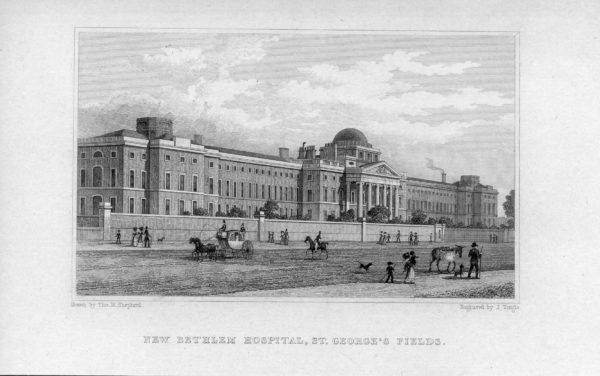Love them or hate them, they’re still in your family
Fratricide – the murder of a sibling – was the most common kin murder and was considered with horror by the press. If insanity was also involved, the public were keen to witness the spectacle of a ‘lunatic’ standing trial for an unnatural crime. This was certainly the case when Llewellyn Edwards stood trial for the murder of his brother, Somersby, in 1862. The courtroom was so crowded with onlookers that proceedings took place in a separate room so that the evidence could be heard above the noise.

"The public were keen to witness the spectacle of a 'lunatic' standing trial for an unnatural crime"
How often do we hear angry children shout ‘I’ll kill you’ when they can’t get their own way? Generally a sign of frustration due to some perceived injustice, the act is rarely carried out. Parricide, or the murder of a family member, goes against the moral code of decent behaviour. From a young age, children are taught to respect their parents and care for their siblings. Where there are rivalries within families it rarely results in murder. In the nineteenth century, it was considered an unnatural crime – and remains so – which invariably attracted much press attention, as it challenged the Victorian concept of domestic harmony.

A gentleman in the Royal Navy
Llewellyn Edwards was a gentlemanly-looking young man aged 21 years who had been born in Daventry, Northamptonshire in 1841. He was the youngest son of Somersby Edwards, a solicitor in Daventry, and his wife, Isabella Easton. His mother and eldest brother, also called Somersby, moved to Wales in the early 1860s and were respectable farmers at Llanon, Dwrclawydd-fach in Carmarthenshire. Llewellyn served as a master’s assistant in the Royal Navy but was wounded in 1859 in South America after which he had an attack of epilepsy. As a result, he was invalided out of the Navy but continued to wear naval uniform.

An act of god
On Sunday 7 September 1862, claiming God was by his side, Llewellyn Edwards, shot his brother Somersby. When the police arrived at the farm they were shown his brother’s body, lying on a board in the front room. He had been shot in the head and there were cuts on the upper part of his forehead. His brains were gone and the scalp cut off. Part of his brain was found on a sickle and a large amount was found scattered, with a great deal of blood, and part of his scalp on the farmyard. Llewellyn was apprehended by police at Pontardulais and conveyed to the lock-up at Llanelly.

"His mother had refused to allow him to be restrained believing that she had complete control over him."
The inquest took place at The Red Lion Inn, in Llanon near Llanelly. Llewellyn Edwards’ father was questioned and stated that the deceased was his eldest son and the accused the youngest. He stated that Llewellyn frequently talked in a strange manner continually reading or chanting psalms and complaining that he had committed grievous sins against God which he would not be forgiven for. His mother had refused to allow him to be restrained believing that she had complete control over him. His father tried to take Llewellyn to Northamptonshire to see if the change would improve his health. Unfortunately, he did not succeed in removing him from his wife and eldest son’s home, an action that resulted in tragic consequences.

The verdict
Llewellyn Edwards appeared before the magistrates at the Town Hall in Llanelly, Carmarthenshire two days later. The court was so crowded that the witnesses had to be questioned in a separate room. Llewellyn was asked about the particulars of his crime and stated:
“On the 27th of July last, I was getting up at seven in the morning to join some young men, when two Angels appeared to me and asked me if I knew what day of the week it was – it was Sunday. I then remained in my bed chamber for six weeks. Yesterday I received a communication from the Lord to shoot my brother, who had broken every Commandment. I found the gun loaded in the kitchen, prepared for me. It was a double-barrelled gun. “
The jury returned a verdict of wilful murder against Llewellyn but, following the evidence of his father, was in no doubt that he was under the influence of extraordinary delusions which had led to the crime. Shown to be in a state of insanity, Llewellyn was removed from Carmarthen Gaol and placed in Bethlehem Hospital where his admission details describe him as maniacal, noisy and tearing his clothes. His mania lasted only a short period of time as he descended into a state of dementia and was disagreeable, dissatisfied and unsociable with the other patients and staff. After six months his manner calmed and he became quiet and orderly.

Kin is kin
On 26 March 1864, he was one of the first male patients admitted to Broadmoor. His family continued to enquire after his health following his admission and regularly sent him parcels of food and tobacco. After all, kin is kin. Llewellyn died at Broadmoor on 16 May 1883 and at the request of his family was buried at Great Woking Cemetery at Brookwood, Surrey – the ‘London Necropolis’ – the largest cemetery in the world at that time. It had two railway stations, one for non-conformists and the other for Anglicans, and was accessed via its own special station – the London Necropolis railway station next to Waterloo in Central London.


This blog was written by Kathryn Burtinshaw
If killing kin wasn’t your thing, our next blog on love will definitely not be as frightening!

